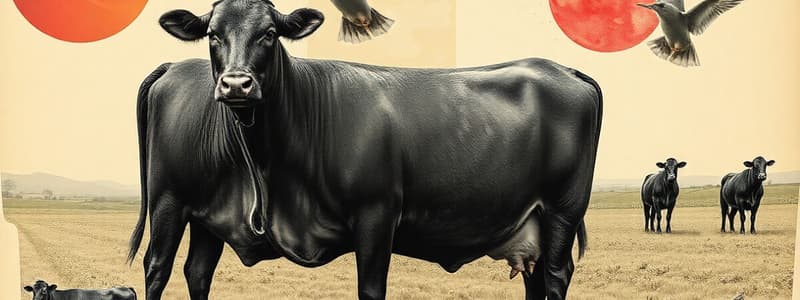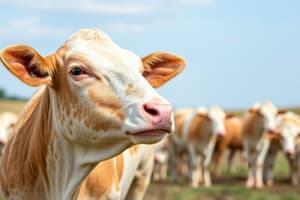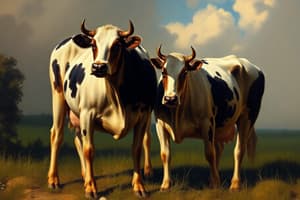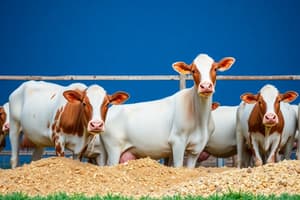Podcast
Questions and Answers
[Blank] is the branch of biology that deals with nutrients and nutrition, especially in animals and plants.
[Blank] is the branch of biology that deals with nutrients and nutrition, especially in animals and plants.
Nutrition
The process by which animals ______, digest, absorb, and use nutrients in feed to support maintenance, growth, work, and reproduction is crucial for their survival.
The process by which animals ______, digest, absorb, and use nutrients in feed to support maintenance, growth, work, and reproduction is crucial for their survival.
ingest
Maximizing animal ______ is essential, as it ensures good health, enhances productivity, improves feed efficiency, and contributes to overall well-being.
Maximizing animal ______ is essential, as it ensures good health, enhances productivity, improves feed efficiency, and contributes to overall well-being.
nutrition
A ______ is defined as a substance that is necessary for an organism to live and grow, enabling animals to carry out vital life processes.
A ______ is defined as a substance that is necessary for an organism to live and grow, enabling animals to carry out vital life processes.
Farm animals primarily obtain their nutrients from ______, plant products, by-products, and animal products, which are essential for their growth and health.
Farm animals primarily obtain their nutrients from ______, plant products, by-products, and animal products, which are essential for their growth and health.
[Blank], carbohydrates, fats, proteins, minerals, and vitamins are the six essential nutrients crucial for animal health and productivity.
[Blank], carbohydrates, fats, proteins, minerals, and vitamins are the six essential nutrients crucial for animal health and productivity.
[Blank], the largest component of living organisms, constitutes 50–75% of an animal's body weight and is vital for survival.
[Blank], the largest component of living organisms, constitutes 50–75% of an animal's body weight and is vital for survival.
The basic functions of ______ include transporting nutrients throughout the body, aiding in digestion, removing wastes, maintaining body temperature, and supporting milk production.
The basic functions of ______ include transporting nutrients throughout the body, aiding in digestion, removing wastes, maintaining body temperature, and supporting milk production.
$C_6H_{12}O_6$, also known as glucose are energy-producing nutrients that should comprise at least 75% of an animal's diet.
$C_6H_{12}O_6$, also known as glucose are energy-producing nutrients that should comprise at least 75% of an animal's diet.
[Blank] are classified into monosaccharides, disaccharides, and polysaccharides and are sourced from pasture grasses, plant products, and by-products.
[Blank] are classified into monosaccharides, disaccharides, and polysaccharides and are sourced from pasture grasses, plant products, and by-products.
Energy deficiency, often due to a lack of ______, is the most common nutritional issue that limits the performance of grazing animals.
Energy deficiency, often due to a lack of ______, is the most common nutritional issue that limits the performance of grazing animals.
Energy deficiencies lead to retarded growth, shortened lactation, loss of body weight, extended anestrus periods, and weak ______ in animals.
Energy deficiencies lead to retarded growth, shortened lactation, loss of body weight, extended anestrus periods, and weak ______ in animals.
[Blank] are organic compounds composed of amino acids and contain carbon, hydrogen, oxygen, and nitrogen, essential for various animal functions.
[Blank] are organic compounds composed of amino acids and contain carbon, hydrogen, oxygen, and nitrogen, essential for various animal functions.
Animals require ______ for building new cells and tissues, producing milk, wool, hairs, and feathers, maintaining body tissues, and synthesizing enzymes and hormones.
Animals require ______ for building new cells and tissues, producing milk, wool, hairs, and feathers, maintaining body tissues, and synthesizing enzymes and hormones.
[Blank] sources includes pasture legumes, field peas, and soybean, while animal sources consist of fish meal, bone meal, milk, meat meal, and blood meal.
[Blank] sources includes pasture legumes, field peas, and soybean, while animal sources consist of fish meal, bone meal, milk, meat meal, and blood meal.
Protein deficiency, often accompanying energy deficiencies, results in reduced appetite, lowered feed intake, impaired muscle development, prolonged time to maturity, and decreased ______ production.
Protein deficiency, often accompanying energy deficiencies, results in reduced appetite, lowered feed intake, impaired muscle development, prolonged time to maturity, and decreased ______ production.
[Blank] are composed of fatty acids and glycerol, contain carbon, hydrogen, and oxygen, and supply more energy than carbohydrates.
[Blank] are composed of fatty acids and glycerol, contain carbon, hydrogen, and oxygen, and supply more energy than carbohydrates.
The purpose of fats are used to supply energy and store energy, with any excess energy from ______ being stored as fat.
The purpose of fats are used to supply energy and store energy, with any excess energy from ______ being stored as fat.
[Blank] provide a range of indispensable services for animal health, including facilitating the proper utilization of proteins, fats, and carbohydrates.
[Blank] provide a range of indispensable services for animal health, including facilitating the proper utilization of proteins, fats, and carbohydrates.
Fat-soluble ______ include Vitamins A, D, E, and K, whereas water-soluble vitamins consist of Vitamins B and C.
Fat-soluble ______ include Vitamins A, D, E, and K, whereas water-soluble vitamins consist of Vitamins B and C.
Vitamin ______ can result in retarded growth, poor reproduction, skin ailments, hemorrhaging, diarrhea, night blindness, rough coat, and muscular problems in animals.
Vitamin ______ can result in retarded growth, poor reproduction, skin ailments, hemorrhaging, diarrhea, night blindness, rough coat, and muscular problems in animals.
Vitamins are sourced from green pasture grasses, legumes, legume hays, silage, cereal grains, oil seeds, sunlight, and injectable ______.
Vitamins are sourced from green pasture grasses, legumes, legume hays, silage, cereal grains, oil seeds, sunlight, and injectable ______.
[Blank] promote healthy growth and development in animals and are classified into macro and micro minerals, each fulfilling specific roles in the body.
[Blank] promote healthy growth and development in animals and are classified into macro and micro minerals, each fulfilling specific roles in the body.
[Blank] and phosphorus contribute to strong teeth and bones, while other minerals ensure strong eggshells and prevent milk fever in dairy cattle.
[Blank] and phosphorus contribute to strong teeth and bones, while other minerals ensure strong eggshells and prevent milk fever in dairy cattle.
Animals can obtain minerals from green pasture grasses, forages, legumes, cereal grains, mineral licks, fish meal, bone meal, and ______ meal.
Animals can obtain minerals from green pasture grasses, forages, legumes, cereal grains, mineral licks, fish meal, bone meal, and ______ meal.
According to an analysis by J.B. Lawes and J.H. Gilbert in 1859, the level of ______ and fat in an animal's body varies inversely.
According to an analysis by J.B. Lawes and J.H. Gilbert in 1859, the level of ______ and fat in an animal's body varies inversely.
J.B. Lawes and J.H. Gilbert's analysis indicates that water, protein, and ash in a fat-free body are present in the ratio of 19:5:1, accounting for 74-76%, 20-22%, and 3-5%, respectively. Meaning that composition of ______ and moisture-free body:
J.B. Lawes and J.H. Gilbert's analysis indicates that water, protein, and ash in a fat-free body are present in the ratio of 19:5:1, accounting for 74-76%, 20-22%, and 3-5%, respectively. Meaning that composition of ______ and moisture-free body:
The ______ content in an animal's body is variable and decreases with age. For instance, a cattle embryo contains approximately 95% water, while a mature animal contains about 50-70% water.
The ______ content in an animal's body is variable and decreases with age. For instance, a cattle embryo contains approximately 95% water, while a mature animal contains about 50-70% water.
The distribution of ______ within the body is not uniform, with blood plasma containing 90-92%, heart, kidneys, and lungs 80%, muscles 75%, bones 45%, and teeth enamel 5%.
The distribution of ______ within the body is not uniform, with blood plasma containing 90-92%, heart, kidneys, and lungs 80%, muscles 75%, bones 45%, and teeth enamel 5%.
[Blank], along with some inorganic elements, is vital for animal body structure and is a major component of dry matter in muscles and other body organs.
[Blank], along with some inorganic elements, is vital for animal body structure and is a major component of dry matter in muscles and other body organs.
Muscles consist of approximately 75-80% ______, which is also present in hair, nails, feathers, hooves, skin, wool, tendons, and bones.
Muscles consist of approximately 75-80% ______, which is also present in hair, nails, feathers, hooves, skin, wool, tendons, and bones.
______ content in an animal's body increases with age and is primarily located in adipose tissues under the skin, around the kidney, intestines, and other body organs.
______ content in an animal's body increases with age and is primarily located in adipose tissues under the skin, around the kidney, intestines, and other body organs.
[Blank], accounting for only about 1% of the total animal body, are constantly formed and broken down, serving a multitude of functions, and are typically present as glucose or glycogen in muscles and the liver.
[Blank], accounting for only about 1% of the total animal body, are constantly formed and broken down, serving a multitude of functions, and are typically present as glucose or glycogen in muscles and the liver.
[Blank] and phosphorus are the most abundant minerals in the body, primarily concentrated in teeth and bones, and represent 70% of body ash.
[Blank] and phosphorus are the most abundant minerals in the body, primarily concentrated in teeth and bones, and represent 70% of body ash.
[Blank], potassium, and chlorine are present in inorganic form in various fluids, while other minerals constitute tissues, fluids, and enzymes.
[Blank], potassium, and chlorine are present in inorganic form in various fluids, while other minerals constitute tissues, fluids, and enzymes.
Flashcards
What is Nutrition?
What is Nutrition?
Branch of biology focused on science and practice of feeding animals, including how animals ingest, digest, absorb, and use nutrients for maintenance, growth, work, and reproduction.
What is a Nutrient?
What is a Nutrient?
A substance necessary for an organism to live and grow, enabling life processes and provided via feed and water.
Where do animals get nutrients?
Where do animals get nutrients?
Plants (grasses, legumes), plant by-products (grains), and animal products (bone meal/milk).
List the essential nutrients.
List the essential nutrients.
Signup and view all the flashcards
Why is water important?
Why is water important?
Signup and view all the flashcards
Roles of Water
Roles of Water
Signup and view all the flashcards
Carbohydrates
Carbohydrates
Signup and view all the flashcards
Types of Carbohydrates
Types of Carbohydrates
Signup and view all the flashcards
Carbohydrate Sources
Carbohydrate Sources
Signup and view all the flashcards
Results of energy deficiencies?
Results of energy deficiencies?
Signup and view all the flashcards
What are proteins?
What are proteins?
Signup and view all the flashcards
Animal needs for Protein
Animal needs for Protein
Signup and view all the flashcards
Sources of Protein
Sources of Protein
Signup and view all the flashcards
Protein Deficiency in Animals
Protein Deficiency in Animals
Signup and view all the flashcards
Fats & Lipids
Fats & Lipids
Signup and view all the flashcards
Sources of Lipids
Sources of Lipids
Signup and view all the flashcards
Vitamins
Vitamins
Signup and view all the flashcards
Role of Vitamins
Role of Vitamins
Signup and view all the flashcards
Vitamin Deficiency
Vitamin Deficiency
Signup and view all the flashcards
Vitamin Sources
Vitamin Sources
Signup and view all the flashcards
What are Minerals?
What are Minerals?
Signup and view all the flashcards
Sources of Minerals
Sources of Minerals
Signup and view all the flashcards
Animal Body Research Pioneers?
Animal Body Research Pioneers?
Signup and view all the flashcards
Water-Fat Relationship
Water-Fat Relationship
Signup and view all the flashcards
Changes in water content?
Changes in water content?
Signup and view all the flashcards
Where is water in the body?
Where is water in the body?
Signup and view all the flashcards
Protein Function
Protein Function
Signup and view all the flashcards
Where is protein found
Where is protein found
Signup and view all the flashcards
About Fat Content
About Fat Content
Signup and view all the flashcards
Fat Location
Fat Location
Signup and view all the flashcards
Carbohydrates Amount
Carbohydrates Amount
Signup and view all the flashcards
Calcium and Phosphorus
Calcium and Phosphorus
Signup and view all the flashcards
Ca and P significance?
Ca and P significance?
Signup and view all the flashcards
Study Notes
Animal Nutrition
- Nutrition involves animals ingesting, digesting, absorbing, and using nutrients from feed for maintenance, growth, work, and reproduction
- Proper animal nutrition leads to good health, increased productivity and feed efficiency, and overall well-being
Nutrients
- A nutrient is a necessary substance for an organism to live and grow
- Nutrients enable animals to carry out life processes
- Animals obtain nutrients through feed and water
Sources of Nutrients
- Farm animals get nutrients from plants, plant products and by-products, and animal products
- Plants include grasses, forage crops, and legumes
- Plant products and by-products include grains (corn, rice, wheat), rice bran, wheat middlings, copra meal, and soybean meal
- Animal products include bone meal, fish meal, meat meal, shrimp meal, and milk
Essential Nutrients
- The six essential nutrients for animals are water, carbohydrates, fats, proteins, minerals, and vitamins
Water
- Water is necessary for an animal to live and is the largest component of nearly all living things
- Animals can survive longer without food than without water
- Water makes up 50-75% of an animal's body weight
- Water transports nutrients, aids digestion, removes wastes, maintains body temperature, and is required for milk production
Carbohydrates
- Carbohydrates are energy-producing nutrients with the formula C6H12O6 (glucose)
- Animal diets should consist of at least 75% carbohydrates
- Animals require energy for metabolic activity, physical work, and the production of meat, eggs, and milk
- Carbohydrates are classified as monosaccharides (glucose, fructose, galactose), disaccharides (maltose, sucrose, lactose), and polysaccharides (starch, cellulose, hemicellulose, lignin)
- Sources of carbohydrates include pasture grasses, plant products, and plant by-products (root crops, fruits, seeds, grains, rice bran, and wheat bran)
Energy Deficiency
- Energy deficiency is a common nutritional problem that limits grazing animals, often due to inadequate feed from overgrazing, drought, poor quality, digestibility issues, or cost
- Forage with excess water can limit energy intake
- Energy deficiencies can result in retarded growth, delayed puberty, shortened lactation, reduced milk production, loss of body weight, prolonged anestrus, and weak or undersized offspring
Proteins
- Proteins are organic compounds made of amino acids, containing carbon, hydrogen, oxygen, and nitrogen
- Animals need protein for building cells and tissues (including muscles), producing milk, wool, hairs, and feathers, body maintenance, and producing enzymes and hormones
- Plants such as pasture legumes, field peas, and soybean are sources of protein
- Animal products such as fish meal, bone meal, milk, meat meal, and blood meal are sources of protein
Protein Deficiency
- Protein deficiency usually occurs with energy deficiencies
- Protein deficiency signs include reduced appetite, lowered feed intake, lack of muscle development, prolonged time to reach maturity, loss of weight, and decreased milk production
Fats & Lipids
- Fats are made up of fatty acids and glycerol, containing carbon, hydrogen, and oxygen
- Fats have 2.25 times more energy than carbohydrates and are used to supply and store energy
- Excess energy from carbohydrates is stored as fat under the skin and in the abdominal cavity
- Sources include oilseed meals (copra, canola, linseed), vegetable oils, tallow, and lard
Vitamins
- Vitamins are organic compounds needed in small amounts for healthy growth and development
- Fat-soluble vitamins include vitamins A, D, E, and K
- Water-soluble vitamins include vitamins B and C
Role of Vitamins
- Vitamins are essential for the use of proteins, fats, and carbohydrates; blood clotting, bone formation, reproduction, lactation, and the prevention of certain nervous disorders
- Vitamin deficiency may result in retarded growth, poor reproduction, skin ailments, hemorrhaging, diarrhea, night blindness, a rough coat, and muscular problems
- Sources of vitamins include green pasture grasses and legumes, legume hays, silage, cereal grains, oil seeds, sunlight, and injectable and packet vitamins
Minerals
- Minerals promote healthy growth and development
- There are 16 essential minerals divided into macro and micro minerals, each playing specific roles in the animal's body
- Calcium and phosphorus aid in strong teeth and bones
- Minerals assist in strong egg shells
- Minerals prevent milk fever in dairy cattle
- Mineral sources include green pasture grasses and forages, legumes, cereal grains, mineral licks, fish meal, bone meal, and shrimp meal
Animal Body Composition
- J.B. Lawes and J.H. Gilbert analyzed farm animal bodies and published their study in 1859
- The levels of water and fat in an animal's body vary inversely
- The Composition of fat-free is Water: Protein: Ash = 19: 5: 1 (74-76% : 20-22% : 3-5%)
- The Composition of fat and moisture-free body is Protein: Ash = 80:20
- The body composition of a moisture-free and fat-free body is practically constant.
Water Content by Age
- As an animal ages the water content in the body will decrease
- A cattle embryo has ~95% water content
- A new born calf has ~75-80% water content
- A 5 month old calf has ~66-72% water content
- A mature animal has ~50-70% water content
Organs Water Distribution
- Distribution of water within the body is not uniform
- Blood plasma contains 90-92% water
- Heart, kidneys and lungs contains ~80% water
- Muscles contain ~75% water
- Bones contain ~45% water
- Teeth enamel contain ~5% water
- Water content level depends on the animal's nutritional status
Other Body Components
- Protein and inorganic elements are responsible for the structure of an animal's body
- Protein is a major constituent of dry matter in muscles and organs
- Muscles contain almost 75-80% protein
- Protein is found in hair, nails, feathers, hooves, skin, wool, tendons and bones
- Fat is an extremely variable body component
- Fat content increases with age
- Fat is within adipose tissues around kidneys, intestines and other organs
- Carbohydrates are only approximately 1% of the total animal body
- Constantly formed and broken down and has many functions
- Usually present as glucose or glycogen in the muscles and liver
Essential Minerals
- Calcium and Phosphorus are the most abundant minerals and are almost entirely present in teeth and bones
- Phosphorus is also associated with protein, fats, and other inorganic salts
- Calcium and Phosphorus major components and represents 70% of body ash
- Sodium, Potassium and Chlorine are present in the inorganic form in various fluids
- Other minerals form various tissues, fluids and enzymes
Studying That Suits You
Use AI to generate personalized quizzes and flashcards to suit your learning preferences.




